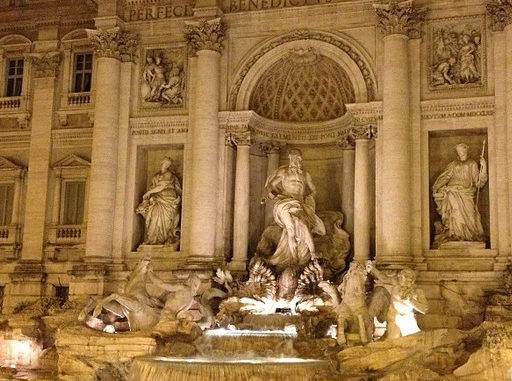
The Trevi Fountain is a beautiful fountain located in the Trevi district of Rome in Italy. It is 161.3 feet/49.15 meters wide and 86 feet/26.3 meters tall. It spills nearly 80,000 cubic meters of water per day. The fountain was designed by Nicola Salvi and the construction was finished by Pietro Bracci.
The Trevi fountain is one of the most well-known and popular tourist attractions in the world and the biggest Baroque fountain in Rome. There are no tickets to visit the attraction. The opening hours are 5 AM to 11 PM every day.
History of the Trevi Fountain
It is believed in 19 BC Roman workers were able to find a source of clean and pure water with the guidance of a virgin. This story is depicted in the current façade of the Trevi fountain.
In the ancient Roman era, the Aqua Virgo Aqueduct constructed by Roman technicians was based on the above story. Aqua Virgo means virgin waters. This aqueduct supplied water to the many baths in the city as well as varied fountains located all over central Rome. The story has also been retold differently, wherein a young beautiful girl escorted thirsty Roman soldiers to the starting place of a spring so that they could quench their thirst.
The Trevi fountain was constructed at the end of the old aqueduct, where three main streets joined. These three roads, i.e., “tre vie”, provide the fountain with its name Trevi fountain, meaning the ‘3 street fountain.’
Pope Urban VIII found the older aqueduct fountain to be inadequate. Hence, in 1629, he asked architect Gian Lorenzo Bernini to design different renovation plans. However, the project was discarded after the pope passed away. A lot of the touches of Bernini can be observed in the current version of the Trevi fountain.
Construction of the new Trevi Fountain
During the Baroque era, there was a trend to have competitions for designing fountains, buildings, etc. Pope Clement XII launched a similar contest in 1730 for building a new fountain. Alessandro Galilei won the contest, but there were many protests over the result as Galilei was a Florentine. Eventually the commission to design and construct the fountain was awarded to Nicola Salvi, a native Roman.
The construction work on the fountain started in 1732 and the first water poured out of it in 1743. A large part of the fountain was constructed using Travertine stone, which was mined from Tivoli, located eastwards at a distance of around 22 miles/35 km from Rome. Travertine is a mineral made of large amounts of calcium carbonate created via deposition from hot springs or other spring waters. Even the Colosseum was built using this stone. Several workers were injured and some even died during the construction. One famous casualty was a stonecutter who died in 1734 after getting crushed by a big slab of travertine stone.
Salvi passed away in 1751 with only 50 percent of the work completed. Giuseppe Pannini took over and the construction finished in 1762 after the placement of Oceanus, the god of the seas, in the central area of the fountain. Pannini replaced the currently seen allegories in place of the sculptures of the Roman virgin ‘Trivia’ and Agrippa as originally planned by Salvi. The Trevi fountain was inaugurated and officially opened by Pope Clement XIII on 22nd May 1762, 11 years after the demise of Salvi.
Design and Iconography
The Trevi fountain’s design is based on 3 main elements of architecture, i.e., a travertine façade, a travertine sea reef, and statues made from Carrara marble.
The centre features a palazzo façade with a robust arch. In the middle of the arch is the statue of Oceanus, riding on a shell-shaped triumphal chariot being pulled by 2 horses, each with a Triton as jockey! One of the horses is unruly and restless while the other one is calm, representative of the varied moods of the sea. The central niche surrounding Oceanus consists of free-standing big columns to facilitate best shade and light conditions.
The statue of Oceanus is 16.4 feet/5.8 meters tall. It was sculpted by Pietro Bracci. The sculpture features a muscular body and a long bushy beard. The facial appearance indicates gentlemanliness and fierce dignity simultaneously. A wand is on his right hand, commanding others. A cloth is being held in his left hand; the cloth piece covers his pelvis area.
In the right of the arch is the statue of Health. She is wearing a wreath of laurel crown and holding a cup; a snake is drinking from the cup. Above her statue is a relief featuring a virgin woman leading soldiers to a water source.
In the left area of the arch is the statue of Abundance. She has the horn of plenty in her hand and an upturned vase is near her feet next to a water source. Above her statue is a relief featuring Agrippa, overlooking his generals as they construct the aqueduct.
The attic has 4 allegorical statues. They are representative of the excellent outcomes of rain on the fertility of Earth and the 4 main produces dependent on supply of water/rain. Beginning from the left, the first statue is holding the horn of plenty and is symbolic of ‘Abundance’ of tasty fruits; the second statue is seen with ears of wheat in the hands that is symbolic of the fertility of crops; the third statue has a cup with clusters of grapes representing the ‘produce’ of autumn; and the fourth statue is of the ‘Joy of Prairies and Gardens’ which is decorated with gorgeous flowers.
The adornments carved as part of the Trevi fountain consist of 30 plant species, including a capper, a wild fig, 4 shoots of ivy, a mulleins bush, lake reeds and marsh marigold, pear cactus, artichoke, oak stump, cymbalaria, taro, and a bunch of evergreen plants. The fountain also features carvings of animals like a lizard, a lion, and a snail.
The Poli Palace forms the background of the Trevi Fountain. It was owned by the Conti Family, who were the dukes of Poli town located in Lazio area. The palace was then passed onto the Sforza Cesarini family and later to the Boncompagni family. The City Hall seized it in 1885. Currently, it is home to the National Institute of Graphic Art.
Restoration of the Trevi Fountain
In 1998, refurbish work was carried out on the fountain. Skilled workers and artisans repaired all cracks and other areas of decline. The stonework was cleaned and brushed. Re-circulating pumps were also added.
In 2013, Fendi, the Italian fashion firm, announced that it would donate more than 2 million Euros for restoration of the Trevi fountain. The renovation started in June 2014 and finished in Nov 2015. Over 100 LED lights were installed as part of the restoration process so as to enhance the fountain’s nighttime lighting. The fountain was reopened to the public on 3rd Nov 2015 after an official inauguration ceremony.
Trevi Fountain – Pictures
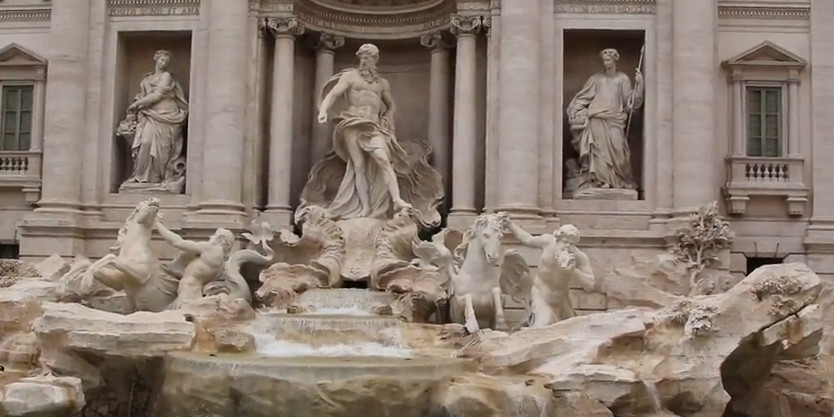
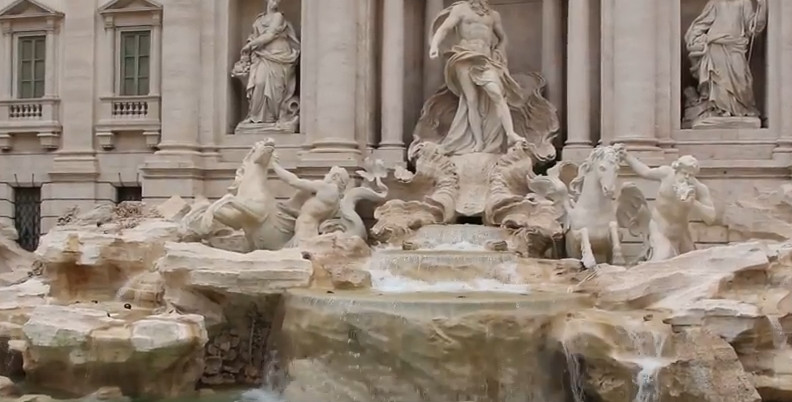
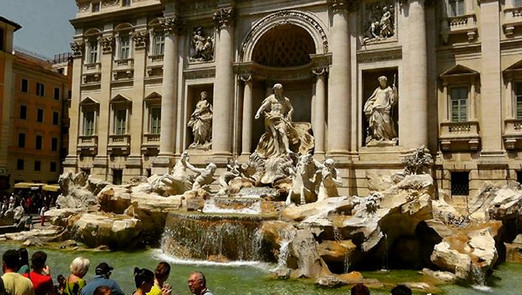
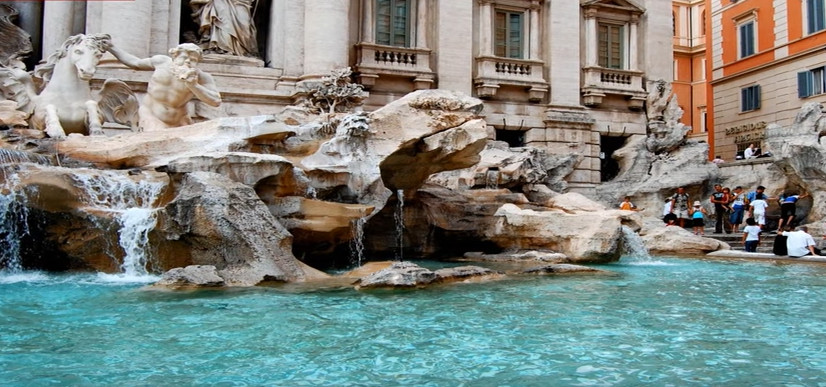
Trevi Fountain – Legend behind Coin throwing
It is believed that throwing coins into the Trevi fountain will ensure that you return to Rome. The coins need to be thrown over the right shoulder with the right hand. Throwing two coins will help one find love, while throwing three coins are for marriage.
The tradition of throwing coins into the fountain can be dated back to ancient Rome when locals often tossed coins in water to please the gods of water and ensure their safe journeys.
As per official records, nearly coins worth 3,000 Euros are tossed into the Trevi Fountain every day. Nearly $1.5 million worth of coins were thrown into the fountain in 2016. The coins are collected by officials every night and donated to a charity that uses the money to subsidize groceries for the needy in Rome. It is illegal to steal coins from the Trevi fountain, but still there have been several attempts to steal the coins. The most famous coin stealer was ‘d’Artagnan’ who raided the fountain waters for almost 34 years before getting caught in 2002.
Trivia
- The water in the fountain is recycled.
- A replica of the fountain is there in Walt Disney World at Epcot
- A postage stamp with the Trevi fountain was launched by the Italian National Postal Service in 1973.
- The fountain has been featured in several movies, including La Dolce Vita, When in Rome, Roman Holiday, The Lizzie McGuire Movie, and Three Coins in the Fountain.
Trevi Fountain at Night – Pictures
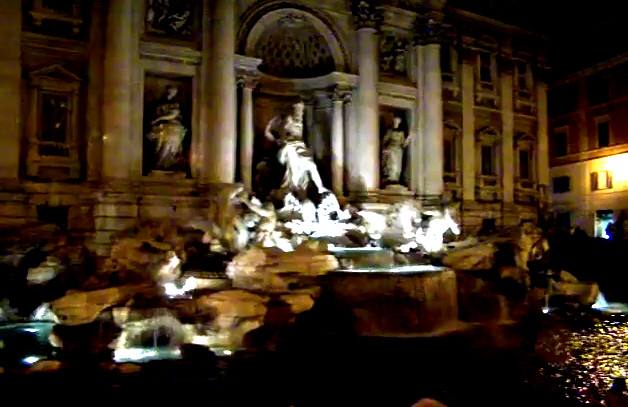
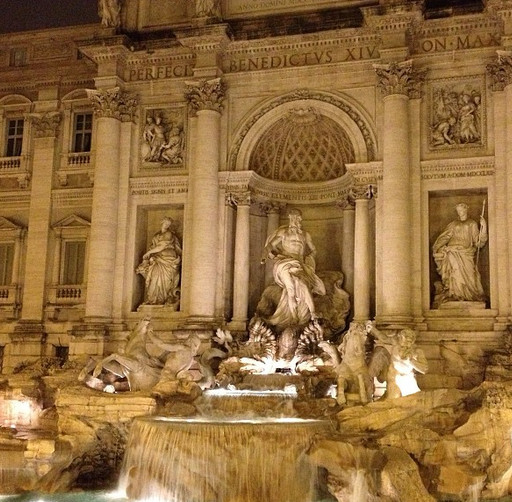
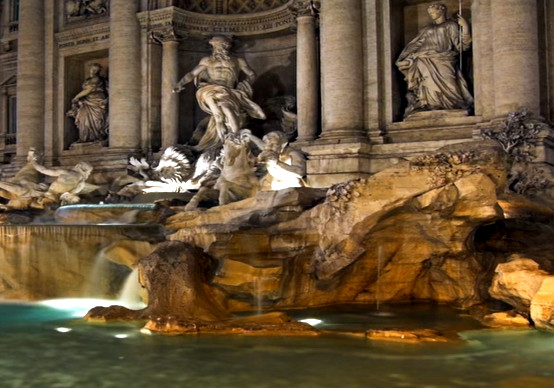
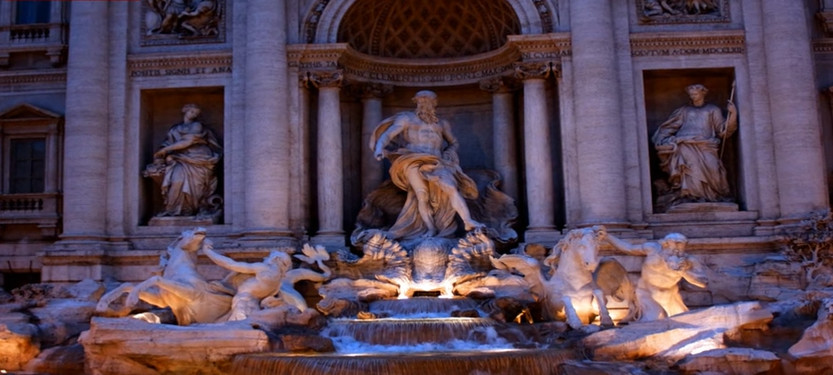
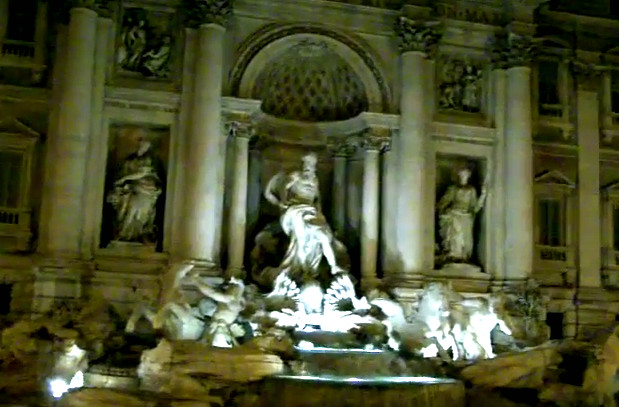
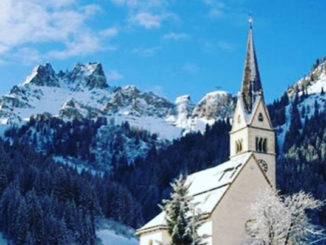
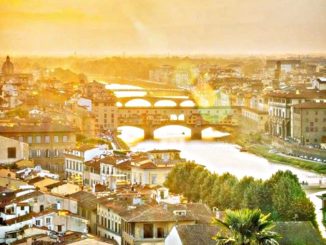
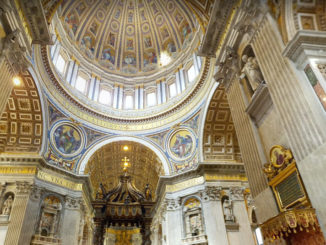
Be the first to comment